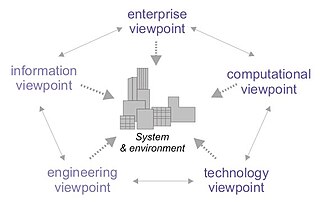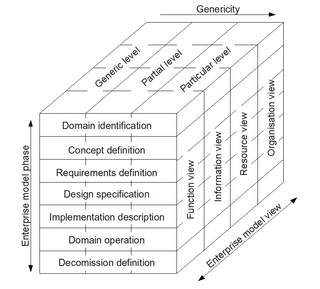This article needs additional citations for verification .(December 2008) |
This article needs additional citations for verification .(December 2008) |
The aim of the NATO Architecture Framework Version 4 (NAFv4) [1] is to provide a standard for developing and describing enterprise architectures for both military and business use. It provides a standardized way to develop architecture artifacts, by defining the following:
The NATO Architecture Framework v4 (NAFv4), issued by the Architecture Capability Team (ACaT) of the NATO Consultation, Command and Control Board (C3B) in January 2018, provides guidance on describing both enterprise architectures and systems architectures.
The objectives of the framework are to:
NAFv4 Chapter 2 provides a methodology which includes how to set up an architecting environment, govern, manage, define and evaluate architectures. The methodology has been developed from accepted best practice and standards, detailing the following:
NAFv4 Chapter 3 defines architecture viewpoints which describe the content, concerns addressed, usage and representation.
NAF Architecture Viewpoints serve as the baseline for any NAF-Compliant architecture description effort.
To aid architects, these viewpoints are organized into a logical and consistent manner and presented as a “grid” similar to that used for the Zachman Framework. This ‘grid’ structure, represents the various ‘subjects of concern’ (rows) and ‘aspects of concern’ (columns), as shown below:
The selection of Architecture Viewpoints must be tailored to the stakeholder concerns associated with the architecture task. Suitable Viewpoints need to be identified in the grid, should additional Viewpoints be required they must be defined.
A View is specified by an Architecture Viewpoint, this prescribes the concepts, models, analysis techniques and visualizations that are provided by the View.
An Architecture Viewpoint typically addresses a set of related concerns and is tailored for specific stakeholders. A NAF Architecture Viewpoint provides an example of a corresponding NAF Architecture View but does not have a mechanism to specify architecture view content.
Note: the NAF version 4 (NAFv4) specifies how views of NAF version 3 (NAFv3) can be reused, i.e. each cell of the “grid” refers to the NAFv3 views and the NAFv4 methodology explains how forward and backward compatibility can be ensured.
Chapter 4 of the NATO Architecture Framework identifies the commercial meta-models which can be used to creation viewpoints described in chapter 3:
Chapter 5 of the NATO Architecture Framework define major definitions and references in line with the major standards and reference documents used in Architecture activities.
Official site to download the latest version of NAF is available (here) or on the (NATO Portal).
Search for “Architecture Framework” and select the “NATO Architecture Framework, Version 4” entry.

Software architecture is the set of structures needed to reason about a software system and the discipline of creating such structures and systems. Each structure comprises software elements, relations among them, and properties of both elements and relations.

The Department of Defense Architecture Framework (DoDAF) is an architecture framework for the United States Department of Defense (DoD) that provides visualization infrastructure for specific stakeholders concerns through viewpoints organized by various views. These views are artifacts for visualizing, understanding, and assimilating the broad scope and complexities of an architecture description through tabular, structural, behavioral, ontological, pictorial, temporal, graphical, probabilistic, or alternative conceptual means. The current release is DoDAF 2.02.
A federal enterprise architecture framework (FEAF) is the U.S. reference enterprise architecture of a federal government. It provides a common approach for the integration of strategic, business and technology management as part of organization design and performance improvement.

Unicom System Architect is an enterprise architecture tool that is used by the business and technology departments of corporations and government agencies to model their business operations and the systems, applications, and databases that support them. System Architect is used to build architectures using various frameworks including TOGAF, ArchiMate, DoDAF, MODAF, NAF and standard method notations such as sysML, UML, BPMN, and relational data modeling. System Architect is developed by UNICOM Systems, a division of UNICOM Global, a United States-based company.
The British Ministry of Defence Architecture Framework (MODAF) was an architecture framework which defined a standardised way of conducting enterprise architecture, originally developed by the UK Ministry of Defence. It has since been replaced with the NATO Architecture Framework.

An enterprise architecture framework defines how to create and use an enterprise architecture. An architecture framework provides principles and practices for creating and using the architecture description of a system. It structures architects' thinking by dividing the architecture description into domains, layers, or views, and offers models – typically matrices and diagrams – for documenting each view. This allows for making systemic design decisions on all the components of the system and making long-term decisions around new design requirements, sustainability, and support.
The Unified Profile for DoDAF/MODAF (UPDM) is the product of an Object Management Group (OMG) initiative to develop a modeling standard that supports both the USA Department of Defense Architecture Framework (DoDAF) and the UK Ministry of Defence Architecture Framework (MODAF). The current UPDM - the Unified Profile for DoDAF and MODAF was based on earlier work with the same acronym and a slightly different name - the UML Profile for DoDAF and MODAF.
IEEE 1471 is a superseded IEEE standard for describing the architecture of a "software-intensive system", also known as software architecture.

Reference Model of Open Distributed Processing (RM-ODP) is a reference model in computer science, which provides a co-ordinating framework for the standardization of open distributed processing (ODP). It supports distribution, interworking, platform and technology independence, and portability, together with an enterprise architecture framework for the specification of ODP systems.
The first version of the Enterprise Collaboration Architecture (ECA) has been published by the Object Management Group (OMG) in 2001. The vision of the (ECA) is to simplify the development of component based and services oriented systems by providing a modeling framework aligned with the model-driven architecture (MDA) of the Object Management Group (OMG).

ArchiMate is an open and independent enterprise architecture modeling language to support the description, analysis and visualization of architecture within and across business domains in an unambiguous way.

A view model or viewpoints framework in systems engineering, software engineering, and enterprise engineering is a framework which defines a coherent set of views to be used in the construction of a system architecture, software architecture, or enterprise architecture. A view is a representation of the whole system from the perspective of a related set of concerns.

Operational View (OV) is one of the basic views defined in the enterprise architecture (EA) of the Department of Defense Architecture Framework V1.5 (DoDAF) and is related with concept of operations. Under DODAF 2, which became operational in 2009, the collections of views are now termed 'viewpoints' and no longer views.

ISO 19439:2006 Enterprise integration—Framework for enterprise modelling, is an international standard for enterprise modelling and enterprise integration developed by the International Organization for Standardization, based on CIMOSA and GERAM.
Enterprise interoperability is the ability of an enterprise—a company or other large organization—to functionally link activities, such as product design, supply chains, manufacturing, in an efficient and competitive way.

TRAK is a general enterprise architecture framework aimed at systems engineers. It is based on MODAF 1.2.
This article documents the effort of the Health Level Seven(HL7) community and specifically the former HL7 Architecture Board (ArB) to develop an interoperability framework that would support services, messages, and Clinical Document Architecture(CDA) ISO 10871.
Model Driven Interoperability (MDI) is a methodological framework, which provides a conceptual and technical support to make interoperable enterprises using ontologies and semantic annotations, following model driven development (MDD) principles.
Software architecture description is the set of practices for expressing, communicating and analysing software architectures, and the result of applying such practices through a work product expressing a software architecture.

Sparx Systems Enterprise Architect is a visual modeling and design tool based on the OMG UML. The platform supports: the design and construction of software systems; modeling business processes; and modeling industry based domains. It is used by businesses and organizations to not only model the architecture of their systems, but to process the implementation of these models across the full application development life-cycle.